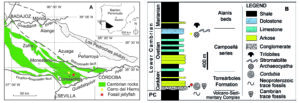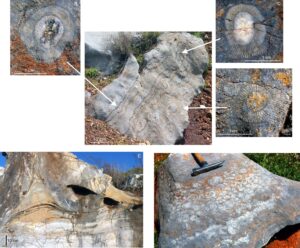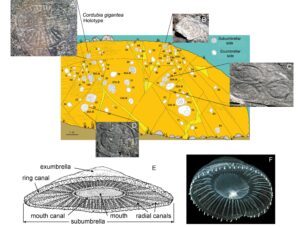Introduction
The Sierra Norte de Sevilla UNESCO Global Geopark has belonged to the European Geoparks Network since September 2011 and to the UNESCO Global Geoparks since November 2015. Within this space are two localities with an exceptional record of Lower Cambrian faunas: the old mine of Cerro del Hierro (municipality of San Nicolás del Puerto), protected as a Natural Monument since 1st October 2003, and the fossil jellyfish site on the shore of the Masacán stream (El Revuelo country state, municipality of Constantina), recognized as Natural Monument since 23rd April 2019.
The Cerro del Hierro locality is a carbonate massif with characteristic paleokarst relief. The locality was greatly conditioned by its historical mining activity. The Cambrian limestone of the Campoallá series, rich in iron ores, was mined since Roman times until the middle of the twentieth century. Miras & Rodríguez (1990) and several other publications describe the mineralogy of the deposits and the landscape values of the locality, but only a few of them include its paleontological sites (Mayoral et al. 2008, 2020).
The unique fossil jellyfish site located in the lower Tierna Member of the Torreárboles Formation at Constantina was first mentioned by Liñán & Mayoral (1992). Later, Mayoral et al. (2004) analyzed it in detail from a taphonomic, systematic and paleobiological point of view, while Gil-Toja et al. (2016) and Mayoral et al. (2019) pointed their heritage value.
Location
From a geological point of view, both sites are located in the so-called Ossa-Morena Zone (a constituent part of the Iberian Massif) and are dated as Early Cambrian (Corduban-Ovetian ages), within the Zafra-Alanís-Córdoba Unit (Fig. 1A), based on a stratigraphic synthesis is shown in Figure 1B.

Figure 1. A) A Geological sketch map with the location of the paleontological sites. B) Synthesis of the stratigraphy of the area. Modified from Mayoral et al. 2004.
Relevance of These Geosites
The intense mining activity at the Cerro del Hierro revealed the presence of magnificent sections of laminar algal bioherms, stromatolites and archaeocyathans in the uppermost part of the Campoallá series (Fig. 2A–D), together with spectacular stromatolites, found near the base of this stratigraphic unit (Fig. 2E–F). Therefore, Cerro del Hierro is a site with one of the most complete and best exposed records of Cambrian bioconstructions in the Iberian Peninsula and the whole of Europe.

Figure 2. Limestones of the Campoallá series. A) Laminated limestone with cross-sections of archaeocyaths (B–D). E–F. Stromatolitic limestone. E) Isolated vertical buildups. F) Front-side sections of a large group of stromatolites with nearly horizontal growth axes.
The unique fossil jellyfish site at Constantina preserves about 90 discoid structures (Fig. 3) each up to 88 cm in diameter (Fig. 3D) which have been described as a new genus and species, Cordubia gigantea by Mayoral et al. 2004 (Fig. 3A). These impressions show outer molds of both the subumbrellar (Fig. 3A–C) and exumbrellar (Fig. 3C–D) sides of the jellyfish and they even show overlapping relationships between them (Fig. 3C).

Figure 3. Sketch of the bedding surface showing the location of some ninety specimens of Cordubia gigantea. A) Holotype. B–D) Paratypes showing subumbrellar and exumbrellar sides respectively. E) Reconstruction of Cordubia gigantea. F) Example of the modern jellyfish Aequorea. Modified from Mayoral et al. (2004).
Mayoral et al. (2004) reconstructed the paleobiological characteristics of these discoid structures and interpreted them as impressions of ancient jellyfish of hydrozoan coelenterates, similar to the extant Leptomedusae genus Aquorea Péron and Lesueur, 1810 (Fig. 3F). Mayoral et al. (2004) also pointed out that this exceptional site as one of the oldest and best-preserved soft-bodied biotas from the Spanish Cambrian record, and also one of the best in the world.
Geotourism and Geotrail Potential
The Cerro del Hierro site gathers an exceptional geological and mining heritage, as well as some special natural habitats, due to the landscape singularity caused by the mining exploitation. Moreover, this natural monument has been prepared for touristic visits with several trails, an information booth and some other restricted paths (used by authorized touristic/educational enterprises). The Cerro del Hierro is the most visited educational and touristic site within the Sierra Norte de Sevilla Geopark.
The Constantina site is a relatively small (ca. 120 m2) outcrop consisting of a bedding plane dipping at 20o formed from a thin ( (<5 cm) layer of medium-grained, parallel-laminated, arkosic greywacke on top of a thick conglomerate bed. The high vulnerability of this geosite still requires the implementation of protection measures in order to receive visits.
Conserving Geosites
The legal background of the Sierra Norte de Sevilla Geopark is the declaration of this territory as a Natural Park by the Law 2/1989, published on 18th July, which approved the Inventory of Protected Natural Spaces of Andalusia.
Both the Cerro del Hierro and the Constantina geosites are included in the Andalusian Inventory of Geo-Resources and in the Geopark Inventory of Geosites and have been proposed as International Geosites. Due to their declaration as Natural Monuments, they have the highest level of protection offered by both the Spanish and Andalusian legislations.
Acknowledgments
We acknowledge support from the Research Group RNM276 of the Junta de Andalucía (Spain) and the Science and Technology Research Centre, University of Huelva.
